
Special edition:
The Edelson Institute
Outlook for 2018
by Sean Brodrick
Contents
- 2017 Was Big. Can 2018 Be Bigger?
- 6 Bears Growling at the Door
- 7 Bulls Pawing at the Floor
- Two Charts to Warm Your Heart
- Oil Bubbles Up
- Copper Shines on China Demand
- What About Gold
- Areas of Interest in 2018
2017 Was Big. Can 2018 Be Bigger?
It is the best of markets. But according to some, it is the worst of markets.
The S&P 500 gained 20% in 2017. But there are those who say it’s on the precipice.
Commodities are booming. But some say they’re about to get shredded.
Crypto currencies are the next best thing … or cryptos are already over.
It’s a confusing world out there. I wouldn’t blame you for being confused. Or even scared.
No one can predict the future with precision. But I can tell you this with great confidence: I think there are some extraordinary opportunities on the table. Ones that, if you miss, you may regret for the rest of your life.
If you aren’t in this market, your odds of missing out on the good days will hurt more than missing out on the bad days.
Now, I’m not some perma-bull Wall Street pumper. It’s simple math.
Per an analysis by Calamos Investments, $10,000 invested in the S&P 500 at the start of 1996 would’ve grown to $43,930 by the end of 2016. An 8.19% annualized return. That assumes a buy-and-hold strategy. Plus, it assumes staying in the market through the Tech Wreck of 2000-’02 and the great crisis of 2007-’09.
However, if you take out the five best days over that time frame, the return shrinks to an annualized gain of 5.99%.
Those big days, when they come, can be extraordinary. And you have to be positioned before they occur.
More recently, breaking it down to individual markets, we saw some of those big days in 2017 in tech (especially semiconductors) … healthcare … defense stocks … banks. And the industry that the rest of the market would like to ignore — cannabis!
And 2018 looks awesome. Not only for cannabis, but for a whole bunch of things I’m going to tell you about today …
Investors see 6 bears growling at the door.
But are they real? Will they bite?
First, let’s deal with what many investors perceive as the “elephant in the room.” That is, the fear that the broader market is overvalued. And along the way, let’s tackle each of the bear arguments that are commonly made.
Bear argument #1: Retail investors are “all-in” and there’s no more money coming into the market.
True, net margin debt in New York Stock Exchange customer accounts hit the highest level in data going back to 2003. And yes, this is typically associated with market tops.
But as I’ll explain in a moment, there’s a lot of new money coming from other sources.
Bear argument #2: U.S. stocks are overvalued compared to foreign markets.
Schroder Investment Management says that the S&P 500 is at its most overbought level in 22 years. And it put out a chart showing the S&P 500 against other global markets. The red means overvalued …
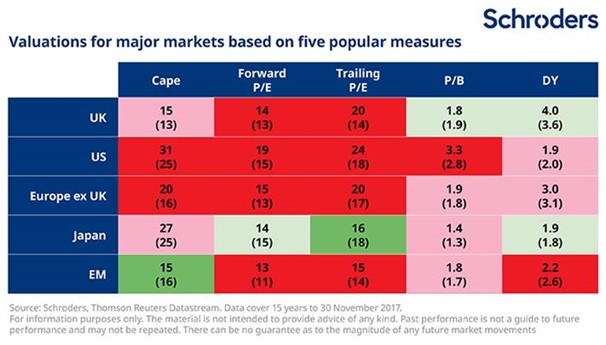
Sure! Absolutely! In fact, this reflects precisely what we have been predicting all along:
Flight capital is flowing out of global markets into the U.S. and should continue to do so. In other words, U.S. stocks will get MORE overvalued relative to foreign stocks. And this is the other major source of money that’s boosting the U.S. market.
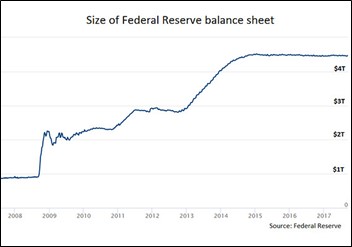 Bear argument #3: The Fed has started to unwind its massive, multitrillion-dollar, QE bond-buying program. You’ll remember that the Fed’s balance sheet grew from about $1 trillion in 2008 to $4.5 trillion today.
Bear argument #3: The Fed has started to unwind its massive, multitrillion-dollar, QE bond-buying program. You’ll remember that the Fed’s balance sheet grew from about $1 trillion in 2008 to $4.5 trillion today.
This is associated with the rise in stock prices we saw at the same time. So when the Fed unwinds … then what?
The Fed started unwinding already, in October, at a rate of $10 billion per month. This will rise every quarter until it hits $20 billion and $30 billion per month.
This will almost certainly lower bond prices and raise interest rates. Some corporations, foreign and domestic, carry debt leveraged to those interest rates. So, this could spark all sorts of trouble for them.
But investors are vastly premature in anticipating the impact of rising rates for several reasons:
-
The Fed has already been unwinding for three months already. And nothing bad has happened yet.
-
The world’s leading companies are flush with cash and are not strangling in debt.
- Interest rates are so low right now that, even if they double, interest costs at most corporations will still be a small fraction of their expenses. Rising interest rates won’t start to take a substantial bite out of corporate profits until they reach much higher levels.
Bear argument #4: President Trump has repeatedly threatened to withdraw from the North American Free Trade Agreement, which might hurt economic growth in North America. His economic and diplomatic advisers persuaded him to delay trade actions in 2017. But, say the bears, 2018 could be different.
The reality: Trump could tinker with NAFTA and trade agreements. But disruptive changes are very unlikely. Moreover, as I’ll explain in a moment, the U.S. contribution to global growth is a lot smaller than most people think.
Bear argument #5: Former FBI Director Robert Mueller’s investigation has snared Trump associates … and could entangle the President himself. At the very least, this would stoke market volatility. It could also trigger a constitutional crisis.
That’s politics. In hard dollars, however, the billions of consumers and hundreds of thousands of businesses that make up the global economy don’t seem to care. They continue to spend and invest regardless of politics.
Bear argument #6: North Korea. Russia. NATO. China. The Middle East. All sorts of overseas problems could affect global markets, and therefore, our markets.
But the facts so far show that the primary affect is mostly bullish: The more trouble we see overseas, the greater the flow of fear money into U.S. stocks and real estate.
Are there enough partial truths in the bear arguments to rile investors? Absolutely! Could they precipitate a sharp market correction? Of course.
But before you reach for a bottle of whiskey, let me show you how the bullish forces are far more powerful …
7 Bulls Pawing at the Floor
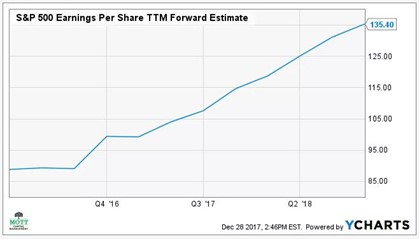 Bullish force #1: Earnings. The estimated earnings per share of the companies in the S&P 500 Index is $114.70. That’s very good.
Bullish force #1: Earnings. The estimated earnings per share of the companies in the S&P 500 Index is $114.70. That’s very good.
Plus, earnings are expected to grow by 18% in 2018 to $135.40. That’s even better.
Michael Kramer of Mott Capital lays out the bull case: Since the fourth quarter of 2013 — admittedly a relatively short time frame — the S&P 500 has been trading around 23 times trailing earnings. Since 1988, just over 21.5 times on average.
The S&P 500 is currently trading at 19.8 times 2018 estimates. But at 21.5 times, he estimates the index would move up to 2,910. And if the S&P 500 makes it up to a 23-times average, that means the S&P 500 could hit 3,100 in 2018.
This would be a 15% gain from year-end 2017.
Bullish force #2: 20 years of consolidation (pent-up buying power).
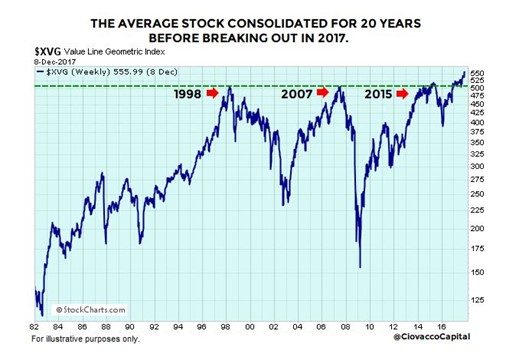 This chart from Ciovacco Capital tells the story …
This chart from Ciovacco Capital tells the story …
It shows a breakout that puts 20 long years of stock market action behind us. So, it would be perfectly within reason to expect the ensuing rise to also span many long years.
Look at it this way …
For two decades, many investors hesitated to buy stocks for fear of bear markets and crashes. And throughout that period, no one could say with any degree of certainty who would ultimately win the bull-bear debate. Now, the debate is over. The bulls are clearly the victors. And all those investors who missed the move so far — whether individuals or institutions … whether domestic or foreign — are looking for the next opportunity to get in.
And here’s a factoid for you. The S&P 500 closed on a “perfect year” — 12 consecutive months of higher closing prices in a calendar year.
The last time this happened? Never.
Bullish force #3: Lower corporate taxes. You know this. But let me say it again:
The GOP plan calls for a permanent reduction in the federal corporate tax rate from 35% to 21%. That’s a whopping 40% tax break and rocket fuel for corporate earnings in 2018.
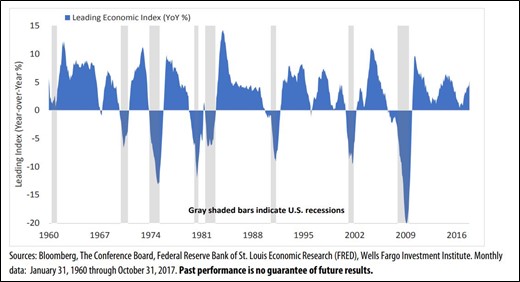 The new tax law also includes a one-time, 12% tax on corporate cash held overseas. This could encourage companies to repatriate hundreds of billions of dollars. Some of that cash would be funneled into dividends, buybacks and capital spending.
The new tax law also includes a one-time, 12% tax on corporate cash held overseas. This could encourage companies to repatriate hundreds of billions of dollars. Some of that cash would be funneled into dividends, buybacks and capital spending.
Bullish force #4: Odds of a recession are falling. That’s according to the Conference Board’s Leading Economic Index. This index has, prior to seven of the past eight recessions, dipped below zero “with few false alarms.”
Now the index is far from zero and rising. This suggests the odds of a recession are receding, not growing.
Bullish force #5: Economic boom. Global growth is improving. According to the World Bank, the global economy is expected to average a Real GDP growth rate of 2.8% between 2017 and 2019.
As you might expect, China will lead the way. It is set to contribute 35% of the world’s expected economic growth in that time frame. The U.S., meanwhile, contributes only 17.9% of the growth. So even in the unlikely event that changes in NAFTA put a damper on the North American economy, the impact will on global growth will be buffered.
Other forecasters are even more optimistic, at least in the short term. Respected forecasters at PwC put global growth at 3.7%. That’s the fastest rate in seven years.
Closer to home, U.S. economic growth in the third quarter of 2017 was 3.3%. That’s the fastest pace in three years.
This is a key reason our colleague Michael Carr expects “More Double-Digit Gains Ahead in 2018.”
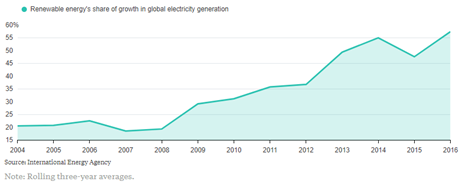 Bullish force #6: Renewable Renaissance. Renewable power now accounts for the majority of growth in global electricity output.
Bullish force #6: Renewable Renaissance. Renewable power now accounts for the majority of growth in global electricity output.
The chart above from the International Energy Agency (IEA) shows how dramatic this change has been since the early 2000s. Back in 2004, renewable energy accounted for just one-fifth of the growth in the electric energy worldwide. Now it’s about three-fifths of the growth. That’s a big deal.
By 2022, renewable energy output is expected to be bigger than the entire electricity consumption of China, India and Germany combined.
And it could accelerate faster, as the cost of renewable energy continues to fall. Meanwhile, the faster renewables grow, the faster new technologies are introduced. And that adds to economic growth.
This is something new the world has never seen before.
Bullish force #7: The Electric Vehicle Megatrend. We are seeing a massive shift in personal transportation. The last time we saw something like this was at the beginning of the 20th century. Then, horse power was on the way out, and internal combustion engine (ICE) transportation was on the way in.
Now, we’re at the end of the “ICE age,” as the world shifts full-bore into the electric vehicle megatrend.
I’ve written many columns about this. Here, here, here and here, for starters. And it’s important to note that all estimates of the growth of the EV megatrend have been too conservative.
That said, the latest from BCC Research says that the global market for electric vehicles will grow from $75.7 billion in 2017 to around $127.7 billion by 2022. That’s a compound annual growth rate (CAGR) of 11.0% for the period of 2017-’22.
This creates multiple spin-off booms — not only in the mining of energy metals, and the building of lithium ion batteries … but also in all sorts of related industries and technologies.
Two Charts to Warm Your Heart
We can’t just count on history repeating itself. We have to be ready for the new opportunities. And that brings me to two charts I posted last week.
You saw them, right?
Well, in case you didn’t, let’s start with this one …
 This is a chart I snagged from Bloomberg and posted to The Edelson Institute site in a column titled: “Your Once-in-a-Generation Buying Opportunity.”
This is a chart I snagged from Bloomberg and posted to The Edelson Institute site in a column titled: “Your Once-in-a-Generation Buying Opportunity.”
This chart compares the Standard & Poor’s GSCI Total Return Index, which tracks 24 raw materials, against the S&P 500.
It shows us that commodities haven’t been this cheap compared to stocks since 1999. A generation is 25 years. So, this is as close as we’ll get to a once-in-a-generation buying opportunity.
As I said in my article:
There are two ways this chart could resolve.
-
Stocks could get a lot cheaper. But our work at The Edelson Institute tells us that, despite the ever-present chance of a correction, stocks are going higher — potentially much higher.
- Commodities could go higher, even faster. Indeed, we’re already seeing this start to happen — the first sparks of what is likely to be a great bull run.
Now, let’s add another chart to that. Here’s a chart I posted to Twitter on Thursday …
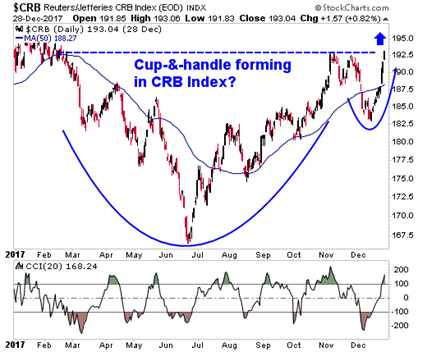 It’s the CRB Index, which tracks a basket of 19 commodities: Aluminum, Cocoa, Coffee, Copper, Corn, Cotton, Crude Oil, Gold, Heating Oil, Lean Hogs, Live Cattle, Natural Gas, Nickel, Orange Juice, RBOB Gasoline, Silver, Soybeans, Sugar and Wheat.
It’s the CRB Index, which tracks a basket of 19 commodities: Aluminum, Cocoa, Coffee, Copper, Corn, Cotton, Crude Oil, Gold, Heating Oil, Lean Hogs, Live Cattle, Natural Gas, Nickel, Orange Juice, RBOB Gasoline, Silver, Soybeans, Sugar and Wheat.
So, it’s a good measure of what’s happening in the commodities market.
See that cup-and-handle pattern on the chart?
Let’s dip our toes in the technical pond for bit. A bullish resolution (breakout) from this pattern would give us an initial target in commodities that is 13% higher than recent prices.
That’s the initial target. It could go much higher.
Let’s look at two commodities in particular: oil and copper.
Oil Bubbles Up
At the end of 2017, the price of West Texas Intermediate, the U.S. crude oil benchmark, pushed above $60 per barrel for the first time in two years. This is despite a parade of doom-and-gloom callers in the mainstream media.
I will point out that we gave you the straight line on why oil was going higher. Here’s one example.
Here’s the key: The Organization of the Petroleum Exporting Countries (OPEC) and a Russian coalition of non-OPEC exporters were able to make production cuts stick.
At the same time, geopolitical tensions in the Middle East and pipeline disruptions from the North Sea to Canada and Libya added more heat.
Finally, global oil demand is growing. Not just for oil, but also for copper …
Copper Shines on China Demand
Our esteemed colleague Matt Badiali hits the nail on the head: “2018 Will Be a Fantastic Year for Copper Miners.”
China has shut down its top copper producer, Jiangxi Copper Co., as part of its war on smog. At the same time, China’s imports of finished copper are soaring. Up 19% year-over-year in November.
China is the world’s largest consumer of industrial metals. It accounts for nearly half of global copper and aluminum demand, estimated at around 23 million tonnes and 62 million tonnes, respectively, for next year.
No wonder copper just jumped to a 3.5-year high! It’s the longest winning streak for the metal in nearly 30 years.
And this bullish story has a long way to run …
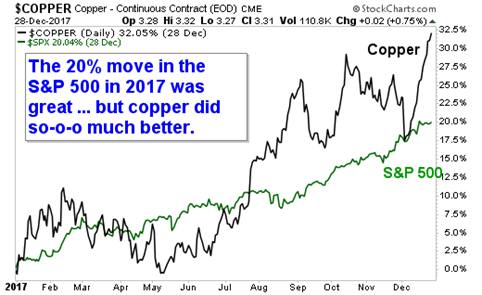 Along with demand, there are problems with supply. There are over 30 labor contracts, covering around 5 million metric tons of mine supply, due to expire next year. Most of them are in Chile and Peru. That could mean strikes at large copper-producing mines in those countries.
Along with demand, there are problems with supply. There are over 30 labor contracts, covering around 5 million metric tons of mine supply, due to expire next year. Most of them are in Chile and Peru. That could mean strikes at large copper-producing mines in those countries.
And that means that this next chart of copper could see its trajectory continue …
I was telling you about “China’s Copper Tsunami” early in 2017. That story looks likely to grow in intensity.
What About Gold?
We are in a seasonally strong time for gold. And this is laid over strong demand from central banks, including Russian and Chinese central banks.
But the main force driving gold prices higher (for now) is a weakening U.S. dollar.
The U.S. dollar just clocked its steepest annual decline in more than a decade, and its first yearly loss since 2012. While The Edelson Institute expects the dollar to recover in 2018, the first half of the year could see more downside.
And that means more upside for gold. Let me show you two charts on that.
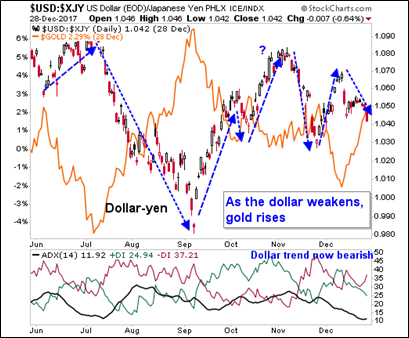 The first chart shows the relationship between gold (the yellow line) and the U.S. dollar/Japanese yen cross-trade. You can see that, as one goes up, the other goes down. I call this relationship “the seesaw of pain.”
The first chart shows the relationship between gold (the yellow line) and the U.S. dollar/Japanese yen cross-trade. You can see that, as one goes up, the other goes down. I call this relationship “the seesaw of pain.”
The second chart, from Optima Investments, shows the longer-term price action in the U.S. Dollar Index INVERTED. And that’s above a chart of gold futures.
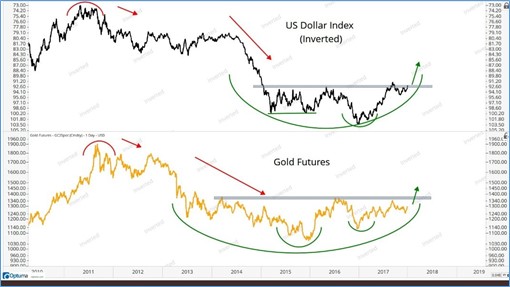 You can see that they’re both ready to break out of chart patterns. These patterns, if triggered, could send gold blasting higher.
You can see that they’re both ready to break out of chart patterns. These patterns, if triggered, could send gold blasting higher.
Why is the dollar weakening? Well, you know that the stock market is an expectations game, right? The currency/forex markets are doubly so.
On an absolute basis, there is no reason any currency in the world should be strengthening vs. the dollar. The Fed hiked rates three times in 2017. It is hinting at hiking three more times in 2018. No other major central bank is even close to doing this, especially not the ECB and BOJ, both of which have ongoing QE programs.
However, the market has already priced in those absolute policies. Right now, that means the second derivative, or the rate of change of change, is driving currencies.
What’s that mean? The market views the chances of the ECB and BOJ getting incrementally more hawkish as greater than the chances of the Fed getting more hawkish.
Put another way, the market is reflecting the view that there’s a better chance we get a hawkish surprise from the BOJ (via dialed-back accommodation) or the ECB (via an abrupt end to QE) than we do from the Fed.
 One last chart: One that shows that, beyond what happens with the U.S. dollar, the bigger picture for gold remains incredibly bullish.
One last chart: One that shows that, beyond what happens with the U.S. dollar, the bigger picture for gold remains incredibly bullish.
This is due to cyclical factors. Gold went through a 5 ½-year-long bear market. During that time, new exploration dried up. Meanwhile, existing mines — having delivered up unrenewable resources — are seeing grades and remaining gold reserves go lower.
It’s a cyclical supply/demand squeeze that should mean much higher prices for gold.
Our precious metals positions in my Supercycle Investor trading service are doing well. Every single one of them is up from the initial recommendation. I expect we’ll do a lot more going forward in 2018.
Areas of Interest in 2018
Big, long-term cycles can sometimes turn slowly. But onward they roll.
In 2018, we’ll place more bets to ride the big cycles — and the massive megatrends — that are evident to anyone with eyes.
Hard work, including boots-on-the-ground research and a systematic approach to investing, should give us an edge over other investors.
Here are areas of interest I find quite appealing in 2018 …
-
Precious Metals: The new bull market that began at the beginning of 2016 seems to be coming out of a correction. The next leg could be quite exciting.
-
Base Metals: Some feed into global growth, some are part of the energy metals boom. Almost all are moving higher.
- Energy Metals: Cobalt, lithium, nickel, copper. Also graphite, which is not a metal, but is vital to li-on batteries. And as Matt Badiali reminded us last week, don’t forget uranium, the “Hated Commodity That Could Make Huge Gains in 2018.”
-
Cannabis: Massive markets are opening up in 2018: California first, then Canada. We’ll also see New Jersey legalize recreational marijuana, and that’s a big state. Michigan is moving ahead. And Massachusetts, which legalized last year, will finally put legislation in place to make it happen. These stocks have enjoyed great runs; a correction is likely. But a correction could lead to a great buying opportunity.
-
Cybersecurity: 2018 will see the first AI hacking programs that are more talented than human beings. That should really scare anyone with electronic money. (All of us.) Jeff Yastine tells you more in “Cyberattacks Prove That No One is Safe.”
-
Electronic Payments: The wave of the future.
-
Blockchain and crypto currencies: An important building block and opportunity in electronic payments.
-
Defense: The war cycles are shifting into higher gear.
-
Renewable Energy and Renewable Tech: Two areas that should see massive growth in 2018.
-
Oil and Gas: This isn’t going away anytime soon. Oilfield tech could be of particular interest.
- Robots: This includes drones. One of the growth areas of the next decade. Automation could affect 375 million jobs by 2030, according to a new report from McKinsey & Co.
As you can see, this gives us plenty to play with. Going forward, I’ll put together a list of playable ETFs in each of these areas. And subscribers can look for specific stock recommendations when applicable to their publications.
Looking forward to a profitable 2018 with you.
All the best,
Sean Brodrick

{ 7 comments }
Thank you for the detailed down to earth tips in a simple manner,of which i can understand.
You’re welcome, Nirmala. Thanks to you as well. Best wishes, Sean
Hello Sean, I just recently became a subscriber of your premium supercycle publication. I bought 2478 shares of UCO approximately two years ago worth $100,000 and saw it take a dive shortly there after now it’s been climbing and I’m up to about $60,000. What do you recommend. Should I continue to hold it or dump it and move the money somewhere else? Thank you
Norge, I’m sorry, but we can’t give individual investment advice. UCO (Ultra crude oil fund) is doing well,l so congratulations. Best wishes, Sean.
A bull is loose in the bear’s den.
Thank You!
One of the best short prediction for 2018 I have seen. It´s valuable to share ideas – nobody knows the future, but somebody knows his Nostradamus better.
Best wishes from Helsiki, Finland.
Thanks, Jarmo. Best wishes, Sean.